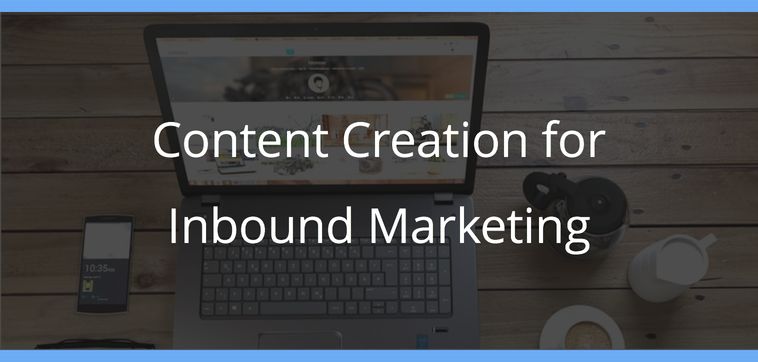A steady stream of fresh, engaging, educational content is the life blood of all good websites (in Google’s eyes for sure) and all content marketing campaigns.
Research shows 91% of B2B marketers use content marketing in their overall strategy, yet how many B2B marketers would say their organisations are effective at content marketing? I'd hazard a guess and say not a lot.
Creating content is a crucial part of the ‘attract’ and ‘conversion’ stages of the inbound methodology and good content has the power to attract visitors to your website by providing them with information they want to consume. Once a simple email address has been provided, the visitor has access your content, and this is where an effective lead nurture pathway should kick into gear to increase your chances of converting that web visitor into a marketing qualified lead - meaning that they are engaged with your business. As that irritating meerkat would say, “Simples!”, but in reality it is far from it and what a lot of effort it takes to get your content right.
The Power of content for Inbound Marketing
Great content is the foundation stone for your Inbound strategy. It can be hosted on your website, shared on social media or included in your email marketing and serves the purpose of helping a potential customer know that you understand the key business challenges that they are facing within any given industry. Good B2B content should educate the reader whilst at the same time demonstrate that your business understands your prospects problems and have the expertise to help overcome them.
Gone are the days of the salesman being the gatekeeper to great information – general principles of marketing today say that over 60% of the sales cycle is now complete before a prospect ever speaks to one of your sales team. Not a myth just a disturbing truth. Prospects utilise the full power of the Internet for research, often late in the evening after the day’s work is done and you need your website to host informative content that can help them with their research whenever they want it. This is where creating great content to encourage a web visitor to discover more about your business and services is crucial and should be delivered across many different channels.
The best content for Inbound Marketing
- Blogs - Google’s search engine loves a great blog post. Blogs are a collection of articles that provide business relevant insights to your target audience. By providing this perspective and understanding, blogs can easily and effectively draw prospects to your website. As part of the Inbound Marketer’s toolkit, they enable businesses to rapidly respond to a change in the industry, they provide a pedestal for a company spokesperson to offer their views on an industry trend and they have great SEO potential.
- eBooks - eBooks are the perfect vehicle to provide content to expand on a business problem or offer a quick ‘How to…’ guide. Easy to consume digital publications, eBooks have the power to provide prospects with short, sharp information and facts without requiring them to wade through large amounts of text.
- Case Studies – Perhaps considered the stalwart of business content, case studies are still a vital mechanism to show off just how good you are and what difference you make to your customers. Your website probably includes hundreds of examples informing the visitor how great you are – but it is much more valuable to have a customer explain how great you are. Case studies provide your prospects with real life examples of how your products or services have solved the very same business problems they are experiencing.
- Whitepapers – a report or guide that helps readers to understand an issue, examine a trend in-depth, solve a problem or make a decision. These are especially relevant for B2B Marketing and have been very useful in lead generation over the last few years. However, they have been over-used. Too often these days we see businesses provide whitepapers as an early piece of content in the lead nurturing pathway – in today’s fast paced, always on the move world very few CEOs, CMOs, CTOs, (or anyone at the decision making level of a business) have the time to sit and read through a lengthy whitepaper in full when still in the awareness stage. Suffice to say, a whitepaper is a piece of content that is typically read by a prospect that is in the final stage of making a purchase decision and should not be used too early within the nurturing pathway.
- Market Research – By undertaking market research and reporting the results on your website in the form of an industry sector research report, not only are you providing prospects with really useful, informative data about the industry they are operating in, but you’re also putting your company out there as a thought leader. Research is great. Statistics are wonderful. Even better is when you combine both of these with insightful analysis from a thought leader to demonstrate that you really do understand the industry.
- Infographics –The colourful, visual interpretations of information we find on infographics is a great way to present complex information quickly and clearly to your prospects. A well-conceived infographic can complement market research really well, displaying the data in a clear and easily digestible form. Bite-size information for those that want to snack not eat a full meal!
Each of these methods of presenting content to web visitors and consequently prospects, are powerful ways to capture their attention and encourage them to come back for more. The difficulty that most organisations face is in creating the processes with ‘time poor’ thought leaders that makes it easy to get good content written down and published.
But it’s vital that company thought leaders buy into Inbound Marketing content creation if the business has a goal of expanding the volume of sales leads that currently being generated. By showing that your business leaders understand your prospect’s problems or challenges and they can suggest solutions through high quality, consistent content, then the Inbound Marketing strategy can get off the ground and the leads will start to flow.
In today’s frenetic world, businesses need to start to think like publishers in their own right. If you’re not generating good content, then you really need to get an agency to help? Behave like a publisher and set deadlines for your articles. Then stick to them!
If you would like to find out more on Inbound Marketing you can read our blog which explains how to make the content generation process much simpler.
Tags: Inbound Marketing





.png?width=60&name=twitter-logo%20(1).png)
